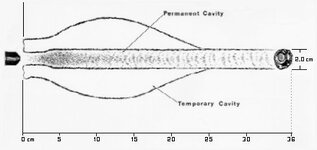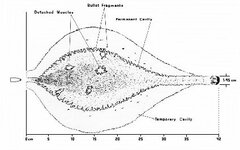The main message I read from ALL comments is that IF you have the resources AND cash to shoot a 223 to 450 yards- sure it'll work- and work well. But MOST average hunters can not do this.
I feel the missing message here is that this forum is not just putting out opinions, but also advice- to NEW hunters. I feel the 223 crowd has made some statements that seem rather absolute (i.e. energy doesn't correlate to terminal ballistics... when we know it does). Etc.
I feel that the 223 shooters HAVE made their point... and it's relevant to ANY forum where opinions (and facts) should be allowed-- even if they are not the same methods of hunting as other seasoned hunters (including myself) would make (or accept). We are ALL free to our opinion and with that I certainly accept the data brought forth by the 223 guys here as valid.
However, I feel they should (as MANY do here) state "the whole truth" and not claim "absolutes" based on what HAS worked for them... I think we can ALL agree you NEED the right gear AND experience to make longer shots with a 223, ethically. And I again do not say the 223 guys do not, but they might further explain some of the gear they MUST use to achieve these kills... I just say they might want to rethink the "message" they send out, and make some "disclaimers" pointed to the fact the gear and "expertise" (they DO have) needs to be in place to make a 450 yard shot on an elk with that bullet. I am NOT saying the bullet won't do the damage... I AM saying you have to PUT that bullet in the right spot to do it.
AND... with that, I am saying it's easier for the AVERAGE hunter with AVERAGE gear to make longer ethical shots with a larger caliber in this particular argument. And I feel (therefore) it is more ethical again to use more than a 223 at 450 yards on anything larger than a coyote. That is just my opinion... but it comes from EXPERIENCE.
Yes, I've seen the wound channels and I'm convinced 100% ANY bullet can kill with a good hit WITH good energy. AND... in the hands of SEASONED shooters WITH the correct (often expensive) gear it's 100% ok to go out and do it with a 223. But let's remember our obligation to FULLY inform the new hunters here of the REALITY of the needed experience AND gear to do what the 223 guys are doing. And let us ALL be humble in explaining these feats... no need for "bravado" (from either camp).
Side note: My own personal reason for not hunting elk with a 223 is that I prefer a non-frangible bullet. And yes, I must admit that using a mono (in some cases) isn't as effective as a frangible at any range too. But after hunting for meat for 45 years, I prefer a bonded bullet's way of killing without a baseball hole on the offside- whether done by a 77g or 200g bullet.
well thought out reply.
the other side we all have to see (to actually help the newer elk hunters) is the magnum pushers, who don't often go into the detailed "why" just they're better for elk, who will discount the success of folks who kill the world with non magnum cartridges. telling them to go get a 300 ultra and brake it if they're a sissy is the worst advice i see given, most new hunters who heed that advice will be worse off than getting a smaller cartridge without the experience to make them consistently devastating on larger game (or smaller for that matter) there are a lot of environments where a brake is not worth having on a rifle (cons outweigh the pros)
the inbetweens aren't often talked about as "ideal" but it seems in a broad brush fashion, they may be (the quick 25's-non mag 30's) may be the best space to live in for the biggest group of elk hunters. for folks newer to hunting and shooting, my main goal will always be handing them a rifle that will not start forming bad habits after the first time the trigger is pulled and in the woods, will never ask them to take a tricky shot, and the outcome will almost always be stellar, don't give new hunters an easy opportunity to make a big mistake, especially with a big tough critter like an elk (that really isn't that tough if your first shot is in the vitals)
i think magnums (more so than pea shooters) are an advanced tool for experienced hunters, in the right hands, they can be spectacular and impressive, especially shooting big critters at extended range with a very experienced hunter and marksman.... they can be equally as ugly in the wrong hands, especially for those relying on a head stamp over experience, which isn't uncommon.
the best thing an inexperienced hunter can do is send a lot of rounds down range with the rifle they will be packing in the woods (especially from field positions) most hunters who aren't already experienced aren't going to go shoot 500 rounds on their own with a rifle that sucks to shoot, or even 100 rounds in a whole year. it seems like the magnum pushers would understand that concept, and add that disclaimer to their advice, but i don't think i have ever seen that happen on the internet.
if the little 223 (with the right bullet within it's effective range) does the destruction it does on critters as big as moose, a 6.5, .257, .270, 7-08, etc scaled with the right bullet is not a bad option.
nobody is saying a new hunter SHOULD pick a .223 with a 77gr TMK for an elk rifle, but it gives excellent perspective on the capability of current projectile options... at least that's what it is for me.
internet forums are like politics in many ways, rather than giving applicable information, they spend their energy trying to discredit theories that don't align with their own, like they need validation for picking the equipment they have.... there is a lot of good information muddied up by people who just want to be right, discounting data to validate their feelings, and then claim they are trying to give good advice.
same BS in the archery space



